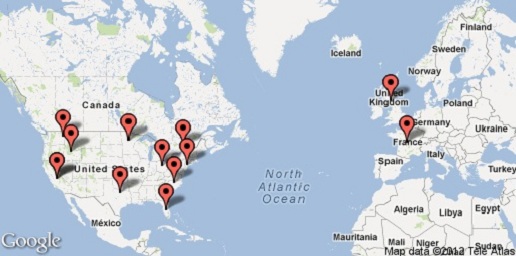
Scrum purists will tell you co-located teams are the way to go. If only it was that easy!
As large organizations adopt scrum, they find themselves struggling with how to be more Agile when many of their teams are distributed. As coaches and trainers, it is our responsibility to support this reality.
There are many blogs and articles like this one on the web that talk about working with remote teams.
Many of the articles I see offer common sense tips like:
- Make the most of tools for instant messaging, video conferencing, and shared content.
- For ceremonies, use video conferencing whenever possible.
- Ensure Team Agreements, Definition of Done, and Definition of Ready are in a shared location.
- Team Agreements need to include core hours when everyone will be on instant messaging.
Here are some of my own more unique suggestions:
- Dealing with time zone differences – Although ceremonies should be at the same time/place whenever possible, consider alternating times by month, or sprint. For example, on odd months favor east coast times, while in even months favor west coast times. Don’t do too small of an increment (like daily).
- Time for a celebration – Ensure everyone on the team, regardless of location, goes out and celebrates. Schedule an extra 15 minutes post scrum to discuss what everyone did. Get creative….hold virtual “coffee breaks” or “pot lucks”; celebrate personal events (such as birthdays, births, leaving, etc) as well as team accomplishments.
- Tracking Sprint Progress – Utilize your tools’ dashboard during daily scrums to show the teams burn-down. Don’t micro-manage tasks. Insist team members keep tasks up-to-date reducing ETC to keep burn-downs current.
- Product Owner – As a Product Owner (PO), engage fully with the team to ensure collaboration leads to comprehensive understanding of each story. Ask questions. Update stories in real-time during team grooming to clarify understanding. It is easy to leave PO acceptance of stories until it is too late for developers to make changes. Instead keep an eye on story progression, review stories as soon as they are ‘done’.
- ScrumMaster as team facilitator – As a Scrum Master (SM), your role is especially important with distributed teams. Pay attention to how members interact. Is everyone participating in ceremonies like grooming and planning? Ask questions to draw out quiet members. Also, just because you are the facilitator, doesn’t mean you have to “be in charge”. Don’t forget to turn items like tasking stories over to developers. Just sit back and listen while they do the work. Consider a SM for each location (e.g., if you have part of the team together on the east coast and another part together on the west coast, use a SM in both places).
There’s no doubt about it…..it’s harder for remote teams to achieve the same collaborative environment that co-located teams can. But it’s not impossible….with a little elbow grease and TLC, your distributed team will shine!”
More from the blog
View All Blog PostsSubscribe to Our Blog
Fill out your email address to receive notifications about new blog posts from CC Pace!
